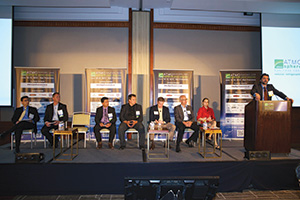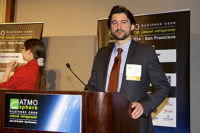
|
| Panel discussions at the Atmopshere America International Workshop in San Francisco spurred a comprehensive discussion on the future of refrigeration and refrigerants. |
As 2014 winds down, the end of new and imported hydrochlorofluorocarbons (HCFCs) is in sight and limitations on certain hydrofluorocarbons (HFCs) seem more and more likely.
So to continue to meet refrigeration needs, f-gas proponents are turning to low-global warming potential (GWP) HFCs and hydrofluoroolefins (HFOs) while advocates of so-called natural solutions — hydrocarbons (HCs), CO2, and ammonia — continue to build their cases.
While the regulatory landscape in North America continues to embrace the naturals, it was only natural that an Atmosphere America International Workshop was held for a third year. In 2014, it took place in San Francisco. Again, the annual event was postured as “a business case for natural refrigerants,” arguing that, regardless how government regulations play out, there is a favorable cost aspect regarding naturals that decision makers should consider when purchasing new HVACR equipment.
California Considerations
While a global HFC phasedown remains in limbo due to international disagreements and President Barack Obama’s efforts to unilaterally impose limits bogged down in domestic politics, natural advocates are eyeing California, which often takes more aggressive actions regarding climate control.
At ATMOsphere America, Keilly Witman, owner of KW Refrigerant Management Strategy, said, “The state of California, a leader when it comes to the implementation of environmental legislation in North America, has committed to reduce the emissions of greenhouse gases by 80 percent by 2050.”
Glenn Gallagher, air pollution specialist, California Air Resources Board (CARB), said actions to reduce short-lived climate pollutants (SLCPs) such as HFCs by at least 80 percent will be necessary in order to help accomplish the goal. To this end, CARB is currently considering a number of measures outlined in the recently published scoping plan that would limit the use of high-GWP refrigerants. Proposed measures include an HFC phasedown, low-GWP requirements, a high-GWP fee, and ozone depleting substance (ODS) destruction offset programs.
CO2
Masood Ali, global leader of center of excellence (COE) for alternative systems, Heatcraft Worldwide Refrigeration, said there is room for growth. He said only about 4 percent of stores in Europe and less than 1 percent in North America use CO2. He contended that European CO2 suppliers are pushing into North America, North American companies are expanding into Europe, and Japanese companies are preparing to enter both markets in the near future. “A huge potential is still untapped,” he said.
One development noted at the event was that Target Corp. is changing the prototype of its stores from HFC-404A to a hybrid HFC-134a/CO2 system.
At the same time, use of CO2 in transcritical systems were reported from Whole Foods, Hannaford supermarkets, and in Walgreen drug stores.
Peter Dee, director of sales and service, North America, Danfoss, talked about the benefits of CO2 in supermarket systems, which include low climate impact, lower life cycle cost, and energy savings. He noted the company was involved in one of the first HFC-free supermarket installations in the U.S., at a Whole Foods store in Brooklyn, New York, which uses a transcritical CO2 refrigeration system. The 56,000-square-foot store also has combined heat and power (CHP) and air-handling units with hot and chilled water.
HCs
Use of HC refrigerants was reported to now being used in more than 500,000 pieces of refrigerated equipment used by McDonald’s, Red Bull, and Coca-Cola Co.
Jeffrey Hogue, senior director, global corporate social responsibility and sustainability, McDonald’s, said R-290 (propane) and R-600 (isobutene) are being used to provide cooling. Paige Dunn, corporate social responsibility and sustainability project leaders, Red Bull, said R-600a is being used in company coolers. Coca-Cola announced it continues to aim for a total phaseout of HFCs in new cold drink equipment as it intends to move to CO2 systems.
Ammonia
Ammonia supporters have expressed a desire to bring the refrigerant to more sites via lower charges. Derek Hamilton, U.S. business development manager, Azane, noted the HCFC-22 phaseout in the U.S. and said low-charge ammonia systems represent an ideal alternative. He cited a low-charge air-cooled packaged ammonia chiller, citing one instance where such a system is installed at a dairy facility in Puerto Rico. It has 190 ton of refrigeration (TR) with a central cooling system, air-handling units, and twin screw compressors.
Sam Gladis, business director for heat pumps, Emerson Climate Technologies Inc., presented a case study of an ammonia-based heat pump installation in a cheese processing facility. The installed ammonia refrigeration system has a compressor load of 14,176 ton and a condensing capacity of 13,319 ton.
An issue arose where the processing plant had a shortfall in condensing capacity in the summer, which resulted in an increase in head pressure from 145 to 170 psig. Gladis said the Emerson ammonia heat pump installation is able to offset some of this.
He said the new configuration enabled the heat pump to act in parallel as a condenser and to replicate the heating capacity of one of the four steam boilers.
Changing Landscape
To give contractors an idea of how the refrigerant and refrigeration landscape can change, the conference examined water in cooling applications specifically related to evaporative cooling. In one example, a project by Genentech at a college is looking at absorption chillers using water as a replacement refrigerant for large central chillers.
And several speakers from utilities discussed the viability of natural refrigerants in equipment regarding energy efficiency as related to the electric grid.
Paul Delaney, manager, Southern California Edison (SCE), said, in the commercial sector, an Albertson supermarket in Carpinteria, California, is a net-zero energy supermarket. It uses natural ventilation and an NH?/CO? refrigeration system. The store’s energy consumption has been reduced by 30 percent, he said. He also noted SCE is working with the Electric Power Research Institute (EPRI) to identify new technologies in refrigeration, focusing on natural refrigerants.
Publication date: 12/1/2014
Want more HVAC industry news and information? Join The NEWS on Facebook, Twitter, and LinkedIn today!






Report Abusive Comment